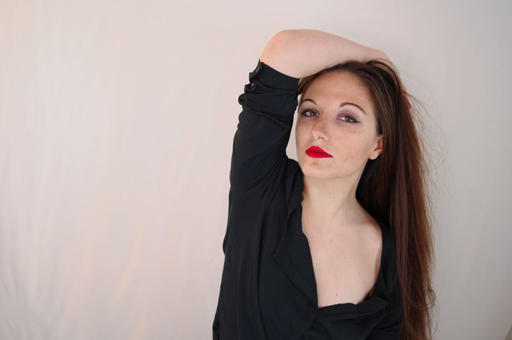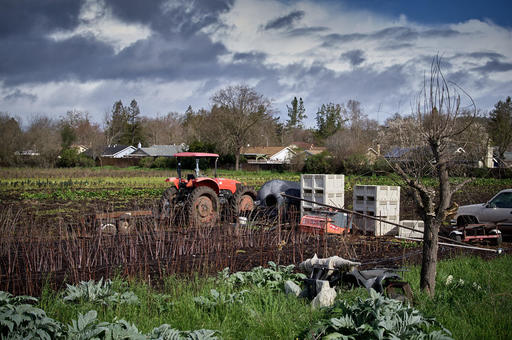Image quality is determined by the tandem of camera and optics. The primary lenses I'm using with the Pentax KP DSLR are the Pentax DA 21mm f/3.2 AL Limited Lens ($496), the Pentax DA 20-40mm f/2.8-4 ED Limited DC WR Lens ($646), and the Pentax DA 70mm f/2.4 Limited Lens ($469). I also have a good collection of full frame lenses that I can use on this body.
 "Brittany" - ISO 800, 20-40mm lens at 27mm, f/3.5, original format Jpeg, no editing. Photo by Derrick Story.
"Brittany" - ISO 800, 20-40mm lens at 27mm, f/3.5, original format Jpeg, no editing. Photo by Derrick Story.
When I set up the camera for testing, I configured Auto ISO for 100-6400 and let the KP use what it wanted. For image format, I'm capturing DNG+Jpeg. The KP provides options for .PEF and .DNG. I'm going with .DNG until there are RAW profiles for the native Pentax format (it's nice to have the option, isn't it?). I set the Program Line to MTF. What that means is, that in Program Mode, the camera opts first for the best aperture for that particular lens. White balance was typically Auto.
 "Irish Pub" - ISO 200, 20-40mm lens at 27mm, f/4.5, original format DNG, tonal adjustments. Photo by Derrick Story.
"Irish Pub" - ISO 200, 20-40mm lens at 27mm, f/4.5, original format DNG, tonal adjustments. Photo by Derrick Story.
These DNGs were decoded in Capture One Pro 10. I also looked at them in Photos for macOS. They looked good in both applications. The Jpegs were often tonally different than the RAW files. Like other camera manufacturers, Pentax has its own secret sauce for Jpeg files. In the case of the KP, they were brighter with a dash of color correction, quite pleasing overall. In many instances, I would post an unedited Jpeg and call it a day.
 "Conversation" - ISO 6400, 20-40mm lens at 40mm, f/5.6, original format DNG, no editing. (Bright window on the left did not throw off exposure in patterned metering.) Photo by Derrick Story.
"Conversation" - ISO 6400, 20-40mm lens at 40mm, f/5.6, original format DNG, no editing. (Bright window on the left did not throw off exposure in patterned metering.) Photo by Derrick Story.
Another aspect that impressed me was how the camera was able to meter in mixed lighting. The KP does a great job of not being fooled by a strong light source from the back or the side. Bright windows were rendered that way without compromising the tones of the primary subject. As a result, I left the camera in patterned metering most of the time, and I rarely had to use exposure compensation. This allowed me to focus more on composition.
 "Morning Walk" - ISO 100, 20-40mm lens at 40mm, f/5.6, original format DNG, light tonal editing. Photo by Derrick Story.
"Morning Walk" - ISO 100, 20-40mm lens at 40mm, f/5.6, original format DNG, light tonal editing. Photo by Derrick Story.
Lens sharpness was good across the board. I did fine tune the 20-40mm zoom using AF Fine Adjustment (Custom Menu Setting 23) to ensure the best focusing accuracy. But I have to say that the combination of Pentax HD optics with the KP DSLR is a beautiful tandem. Overall image quality is outstanding.
 "Sonoma County Farm" - ISO 100, 20-40mm lens at 40mm, f/5.6, original format DNG, graduated screen to add more detail to sky. Photo by Derrick Story.
"Sonoma County Farm" - ISO 100, 20-40mm lens at 40mm, f/5.6, original format DNG, graduated screen to add more detail to sky. Photo by Derrick Story.
Then, there is the color. We've come to expect excellent color from Pentax cameras, and the combination of the KP DSLR and HD optics extends that tradition. Sorting the images in Capture One Pro was a delight, to say the least. The greens have a tremendous amount of vigor, the reds were well-controlled, and the blues were pleasing and natural.
 "Dibs" - ISO 200, 21mm lens, f/3.2 at 1/6th of a second handheld, original format DNG, no editing. Photo by Derrick Story.
"Dibs" - ISO 200, 21mm lens, f/3.2 at 1/6th of a second handheld, original format DNG, no editing. Photo by Derrick Story.
And finally, don't underestimate the contribution of the 5-axis Shake Reduction system toward image sharpness. When shooting the above portrait of Dibs the Cat, I didn't realize that my shutter speed had slowed to 1/6th of a second. I had forgotten that I had locked the ISO at 200 instead of using the Auto ISO setting that provided a range of 100-6400. But the Shake Reduction system saved me, and the image is remarkably sharp.
Final Thoughts on Image Quality
I have no idea how the Pentax KP will rate in the forthcoming lab tests from various photography publications. But the thing that impressed me was that I didn't have to worry about image quality.
What I did was mount good optics on the body, configured Auto ISO and Program Line to let the camera do the heavy lifting, and I just focused on composing interesting pictures. And the results were terrific.
The Pentax KP DSLR is shipping now for $1,099.
More Articles About the Pentax KP
Pentax KP Review - Part One - Top Deck - An overview of the Mode dial, Function dial, and other controls on the top panel of the camera.
Pentax KP Review - Part Two - The Back Panel - An overview of back panel controls and the menu system for the Pentax KP.
You can share your thoughts at the TDS Facebook page, where I'll post this story for discussion.











